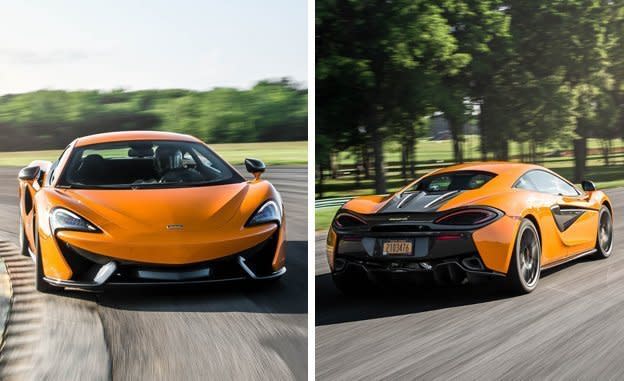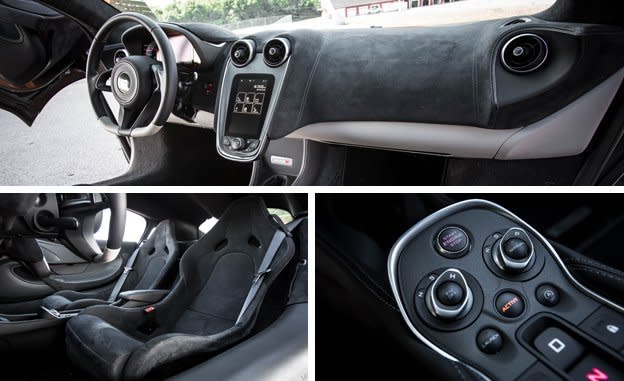2016 McLaren 570S Coupe

Under heavy braking, with its front tires loaded mightily as they near the edge of grip, the McLaren 570S reveals itself. In these telling seconds before the brake pedal is released and the steering wheel is turned, the 570S feels more organic than mechanical. More living tissue than aluminum and carbon. Like a great white shark, maw agape, arcing to carve through a sea lion, it destroys corners. Cleaves them clean through.
It’s a machine that lives for the edge of grip, pleading to be pressed harder, driven in deeper, and throttled sooner. And it is spectacular.

A Supercar, But Not a Track Car?
The 570S—with the exception of minor differences in its carbon tub, its suspension, and its aerodynamics—is essentially the same as the higher-powered 650 and 675 models, and it remains a proper supercar. It even checks all the boxes: mid-engine, rear-wheel drive, absurd doors, gas-station pièce de résistance. In this application, McLaren’s 3.8-liter twin-turbocharged V-8 churns out 562 horsepower and 443 lb-ft of torque. Capable of 8100 rpm, the peewee V-8 is both smooth and loud—a seemingly at-odds combination that goes together here like Chevrolet and pushrods. Power is coupled to the ground via a paddle-shifted seven-speed dual-clutch automatic gearbox.
Ironically, a huge portion of the 570S’s allure is what’s not there: weight. Our test car weighed in at 3189 pounds—hundreds of pounds lighter than virtually anything else daring to press itself into the McLaren’s tiny slice of the super-sports segment. In fact, absence of flab is so coupled to the McLaren’s character that it largely defines this supercar.
Direction changes are a spectacular slip of physics, the steering wheel alive with feedback. Undulations, holes, even pebbles on the surface, pervade the wheel’s constant busyness on a real road, belying its relatively narrow (225 millimeter section width) front rubber. Braking hard brings the need for a purposeful grip on the wheel as its transferal of every surface nuance moves through the chassis. Indeed, complacency has no place behind the wheel of a 570S.
The other effect of minimal mass, of course, is feeling the full-focused fury of a blown V-8. Although its turbos are big enough to lag slightly, the upshot is frenzied acceleration shortly thereafter. Pull the trigger too early on this carbon-bellied Brit and the torque hit will order the rear tires to lead the fronts. Opposite steering lock—quickly, at that—is required.
But just beneath the surface madness there’s a competence undergirding the experience. A sense that some of this, at least, is intentional—the mixed mechanical passion of driving enthusiasts and engineers. It’s not dangerous. It doesn’t want to leave the road. It doesn’t spill oversteer gratuitously onto every corner exit unless told to. And even its braking, which can be harrowing, adds to the 570S’s character. It is, at the end of the day, becoming.

Part of the McLaren philosophy, unlike many cars this capable, is a subtle approach to turning and putting down power. The 570S relies on a brake-steer system to help rotate the car by applying more braking force to the inside rear wheel. There isn’t even a real limited-slip differential here, yet it never mattered in our driving, which included both mountain-road thrashes and timed laps on several tracks. Two knobs, Powertrain and Handling, each offering three drive modes—Normal, Sport, and Track—allow independent control of ride/handling and powertrain response.
The 570S, after all, isn’t intended as a focused track car (for those so inclined, McLaren just announced a special Sprint version based on the car it races in FIA GT4 competition). McLaren’s serious track car is the 675LT. This “lesser” McLaren is, in a sense, a plaything. Sure, there’s real hardware here—carbon-ceramic brakes, for example—which belong in any car this fast and costly. But as supercars go, this one plays loose and fast, balancing the virtues of manic fun and acceptable terror. And that’s a good thing, a thing that can only come in a car with no glaring committee compromises and, strangely, no unyielding track commitments.
Makes the Numbers
Don’t think for a second that the numbers are compromised. They’re not. If the 10.7-second quarter-mile doesn’t convince you, possibly the 134-mph trap speed will. Probably the 2.9-second zero-to-60-mph time won’t hurt, either. If shifted at redline, the 570S never falls off boost, and its carefully calibrated launch control yields probably the most drama-free takeoff in the supercar spectrum.
Those optional carbon-ceramic brakes work, too. And considering the 570S’s $187,300 base price, checking the $1060 box that puts them on the car is a no-brainer. With so little mass to lull, they halt the 570S from 70 mph in only 144 feet, 10 fewer than the 675LT we tested earlier this year.
Despite modest rubber by class standards, the 570S circles the skidpad at 1.05 g, which is respectable but short of the 1.07 g we saw in our test of the 650S Spider and well behind the brain-crushing 1.19 g the Chevrolet Corvette Z06 offers.
Livable, Terrifying, Awesome
Among McLaren’s claims for the 570S are easier entry and egress than the 650 and 675 models, in which the high rocker sill rises steeply upward as it nears the A-pillar, creating a territorial dispute with the space your feet would like to occupy as they swing into the footwell. In the 570S, that sill is cut lower allowing an easier butt-in-seat rotation to driving or riding position. It’s among many fine interior details—such as synthetic suede, carbon-fiber trim, and relatively usable controls—that fade into insignificance as you settle into a rhythm using this McLaren as intended.
That our $219,770 tester left us impressed is hardly surprising. Any car this costly should tingle a driver’s neurons on a high level. What’s special here is that the 570S does it with charisma—sometimes leaving us pleading for the next corner and at other times fearing it. But every time we mashed the brakes and clenched the wheel, we were reminded that this isn’t a dedicated track car. Although close, it isn’t the absolute fastest way down many roads. But it might just be the most rewarding. It’s certainly something special. And that’s always worth a few scares.
Specifications >
VEHICLE TYPE: mid-engine, rear-wheel-drive, 2-passenger, 2-door coupe
PRICE AS TESTED: $219,770 (base price: $187,300)
ENGINE TYPE: twin-turbocharged and intercooled DOHC 32-valve V-8, aluminum block and heads, port fuel injection
Displacement: 232 cu in, 3799 cc
Power: 562 hp @ 7400 rpm
Torque: 443 lb-ft @ 5000 rpm
TRANSMISSION: 7-speed dual-clutch automatic with manual shifting mode
DIMENSIONS:
Wheelbase: 105.1 in
Length: 178.3 in
Width: 75.1 in Height: 47.3 in
Passenger volume: 49 cu ft
Cargo volume: 5 cu ft
Curb weight: 3189 lb
C/D TEST RESULTS:
Zero to 60 mph: 2.9 sec
Zero to 100 mph: 6.1 sec
Zero to 130 mph: 10.0 sec
Zero to 150 mph: 13.9 sec
Rolling start, 5–60 mph: 3.7 sec
Top gear, 30–50 mph: 5.2 sec
Top gear, 50–70 mph: 3.3 sec
Standing ¼-mile: 10.7 sec @ 134 mph
Top speed (mfr's claim): 204 mph
Braking, 70–0 mph: 144 ft
Roadholding, 300-ft-dia skidpad: 1.05 g
FUEL ECONOMY:
EPA city/highway driving: 16/23 mpg
C/D observed: 13 mpg

 Yahoo Autos
Yahoo Autos 